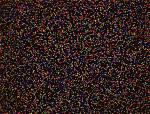
Credit: Madeleine Price Ball
Remember that nucleotides of the DNA have the property of base pairing, where the letter A (Adenine) forms a hydrogen bond with the letter T (Thymine) and the letter C (Cytocine) forms a hydrogen bond with the letter G (Guanine). Let’s use an example of a string of DNA like this:
5′-ACGT-3′
The DNA string shown above will form hydrogen bonds with a complementary string like this:

The first string shown above is called single-strand DNA, also abbreviated ssDNA, while the second set of two strings is called double-strand DNA (dsDNA). Within an organism the DNA is usually double-stranded forming the famous double helix.
Notes on Notation: Representing DNA Strings

The notation 5′- and -3′ is used to show that DNA has a direction where 5′ is the “head” of the DNA string while 3′ is the tail of the DNA string. (5′ is read as “five-prime” and 3′ is read as “three-prime.”)
The symbol “|” shows the hydrogen bonds between the two strings. Here, "complementary" means that As in the first string are replaced by Ts in the second string; and Cs in the first string are replaced by Gs in the second string. The bonds between the top string and the bottom string is called “base-pairing” where the term “base” refers to the nucleotides (because their pH is basic) and “pairing” refers to the hydrogen bonds.
Note here that the top string goes from 5′ to 3′, left to right, while the bottom string goes from 5′ to 3′, right to left. This is the usual way in which two DNA strings are paired together into the double helix. The first string goes from 5′ to 3′ in one direction; the second string goes from 3′ to 5′ in the opposite direction.


 Discovering the Genome
Discovering the Genome